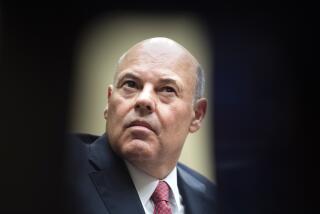Does the Postal Service Deliver Value?
- Share via
When the price of a first-class letter goes up to 37 cents today, consumers should be angry--but not about having to buy more penny stamps. They should be angry that the post office doesn’t give them the information they need to evaluate whether an almost 10% rate hike makes sense.
Part of the problem is that there is no longer adequate oversight of the United States Postal Service. As an independent government entity, the USPS has the power to set its own rates. Even the Postal Regulatory Commission, or PRC, which represents the public and weighs in on rate-making, has no statutory authority to direct the Postal Service to follow its advice.
Another problem is that the USPS’ finances are so sketchy that consumers are basically asked to take the agency’s word on faith. The General Accounting Office and even the PRC’s Office of the Consumer Advocate, for example, have called on the Postal Service to provide the public with better operating and financial information. And no wonder. Try to make sense of the parts of the financial statements that the USPS posts online and you’ll soon discover you need an accounting degree.
The one thing that is clear is the USPS is losing a lot of money, $1.7 billion in fiscal year 2001. However, the service’s cloudy finances make it impossible to know why it’s in the red. USPS executives say they are losing money on first-class mail. Could be, but it’s dangerous to take a monopoly’s word on faith.
The need for more information is especially pressing because the USPS is pushing some major changes in the way it does business, and that could prove to be a very bad deal for consumers. At the same time that the USPS is raising the costs of a first-class letter, it is lowering the cost of services for big commercial mailers. Even worse, the post office is pushing Congress to give it new authority to cut the price that junk mailers pay.
The USPS argument for these seemingly outrageous positions is that by offering volume discounts on postal rates to large commercial firms the Postal Service will attract a greater volume of commercial mail--including junk mail--thereby strengthening its overall bottom line.
There are other serious questions for consumers. Is the rise in first-class mail rates actually subsidizing junk mail, instead of the other way around? And why should a public agency be promoting junk mail, which most U.S. residents consider a nuisance and a waste of natural resources?
There is also the danger that if the Postal Service begins charging commercial mailers less for a higher volume of mail, it will lose even more money. If so, we may look back fondly on 2002 when a first-class letter cost “only” 37 cents. Increases for first-class mail may start coming faster and faster, as the USPS subsidizes large corporate mailers at the expense of consumers and small businesses.
What American consumers want and need from the post office is universal service. Unless Congress and the public know more about the financial workings of the USPS and have more controls over the service’s decisions, stamp prices will continue to up while the Postal Service will go even further into the red.
The USPS certainly faces serious problems that require innovative solutions. But just asking us to pay more for stamps while taking the Postal Service’s recommendations on blind faith is not the way to go. The Postal Service should do its best to protect the interests of all consumers, not just the larger ones, and open up its financial processes to greater scrutiny.
*
Ken McEldowney is executive director of Consumer Action, a national consumer advocacy and education membership organization.
More to Read
Inside the business of entertainment
The Wide Shot brings you news, analysis and insights on everything from streaming wars to production — and what it all means for the future.
You may occasionally receive promotional content from the Los Angeles Times.










